What is enamelware
Enameled utensils are made of metal, however, they are distinguished from ordinary iron or cast iron utensils by a special coating called enamel. Enamel prevents oxidation of metals during cooking, which helps protect food from harmful impurities. But the disadvantage of this coating is excessive fragility. A slight impact can cause cracks to form on the surface of the cookware, resulting in chipping.
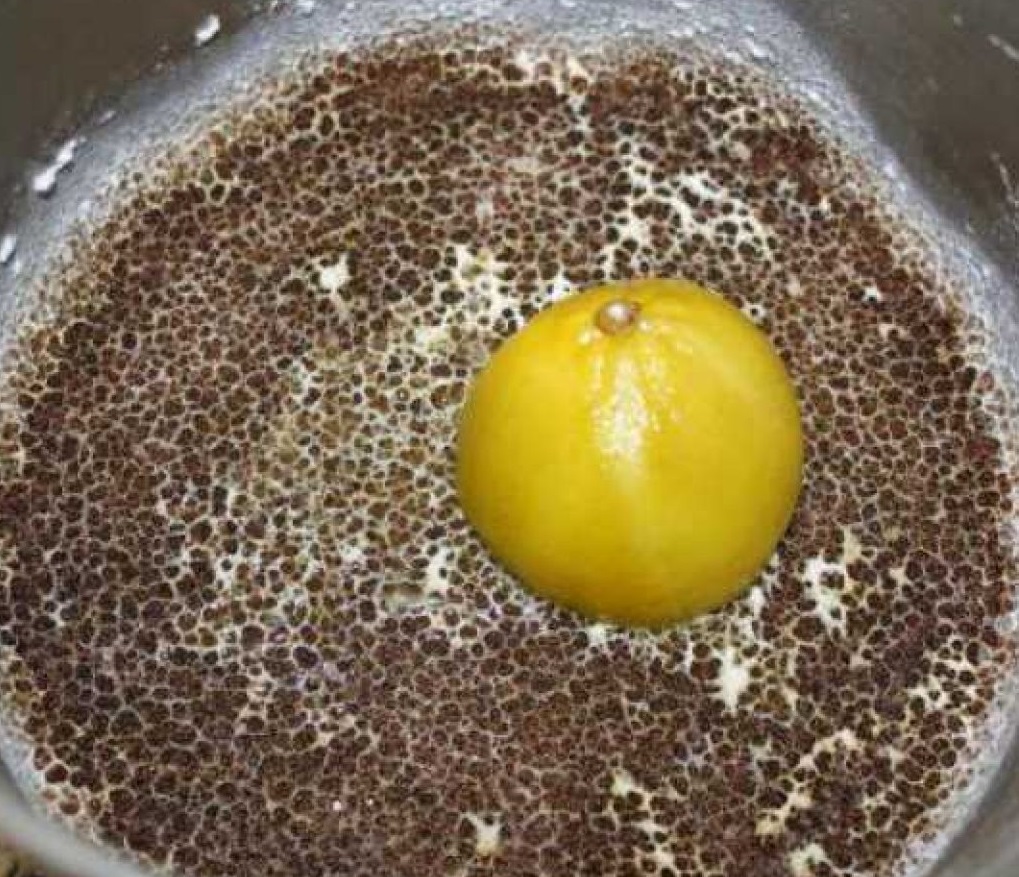
Is it possible to cook jam in a pan
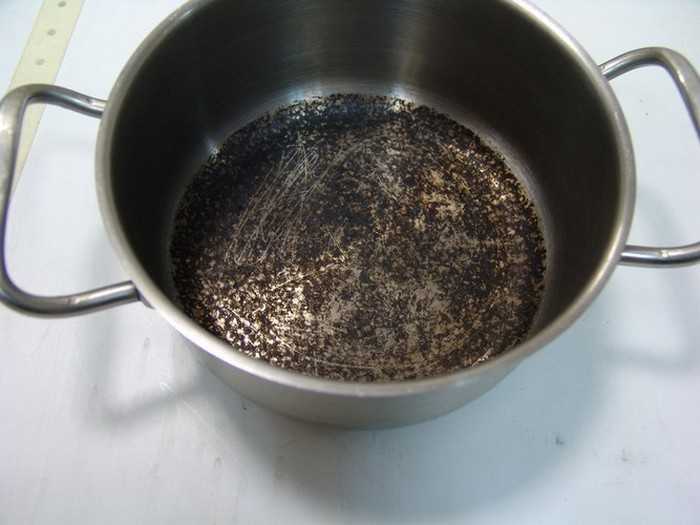
The question that causes controversy is whether it is worth cooking jam in a saucepan at all? And if so, in which pan does the jam not burn?
- It is recommended to cook jam in a shallow but wide bowl. Basins and large bowls are ideal for this purpose. In them, the berries will not crumple, and the chances of getting soot at the bottom are significantly reduced (but do not disappear by 100%).
- Tall pots are not suitable for cooking jam - the liquid from them evaporates poorly, and therefore the jam remains watery. And fruits and berries lie on the bottom.
- Despite the fact that stainless steel is quite inert, you should not cook jam in such pans. Berries and fruits easily stick to the bottom, it is not easy to clean them.During heat treatment in stainless steel dishes, some of the useful substances disappear.
- Aluminum dishes are yesterday, they are not suitable for jam (in extreme cases, for five-minute jam, which does not require long contact with the surface of the dish). Aluminum actively enters into a chemical reaction, oxidizes, some of the ions pass into products.From the acid, dark spots remain on the surface, and the jam acquires an unpleasant “metallic” taste.
- There are more chances to prevent the jam from burning if you cook it in a non-stick cookware, in a saucepan with a thick bottom or in a special heat-resistant glass saucepan - nothing will definitely stick to the glass.
Each pot has its own "pill"
- Aluminum saucepan.
Our grandmothers used aluminum bowls to prepare a sweet product. A number of studies have shown that the use of this metal is strictly prohibited for cooking sour fruits, since aluminum emits active harmful particles and, when combined with acid, can be harmful to health. Cleaning an aluminum pan, if it was nevertheless used for jam, should be done carefully. - Enameled bowl.
Dishes made of such material can be used for many years if properly cared for and protected from impacts. True, jam in enameled dishes is cooked for a long time, and the risk of burning it is higher. - Cast iron pot.
Cast iron is ideal for cooking. In such a saucepan, you can cook jam, but only if you transfer it to jars immediately after cooking. It is not recommended to keep jam in a cast-iron bowl. - Refractory ceramic pot.
Dishes made from this material are environmentally friendly. It is safe to use and easy to clean and wash.Refractory ceramics are ideal for making jam.
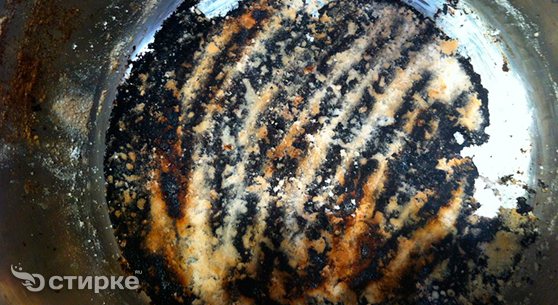
Enamelware
Enamelware is not intended for cooking jam. Experienced housewives know that the jam will almost certainly burn in it, and it will be difficult to wash it so as not to damage the enamel.
But if trouble has occurred, and a dark crust remains at the bottom, then try cleaning the enameled container with soda or citric acid.
To do this, you need to fill the pot or bowl with a solution of 5-6 tbsp. l. soda (or 3-4 tablespoons of citric acid) per 1 liter of water and boil for 10-15 minutes. The burnt layer will become loose and easily move away.
If dark spots remain on the bottom, they can be removed with any bleach containing chlorine. After that, you need to wash the dishes in running water until the smell disappears.
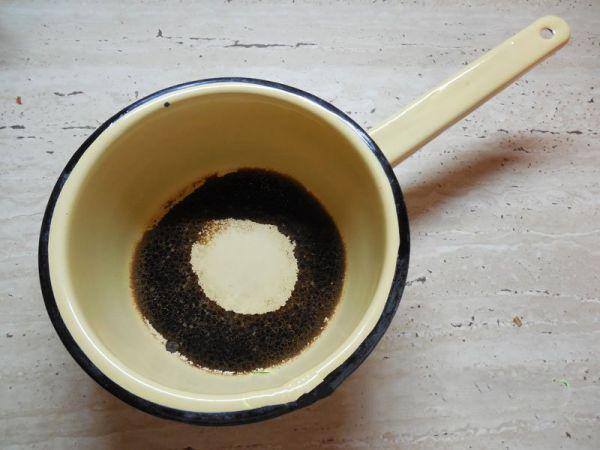
Reasons for burning food
Why do porridge, jam and other foods burn at all? Why do enamel, stainless steel, aluminum, cast iron and even non-stick coating burn?
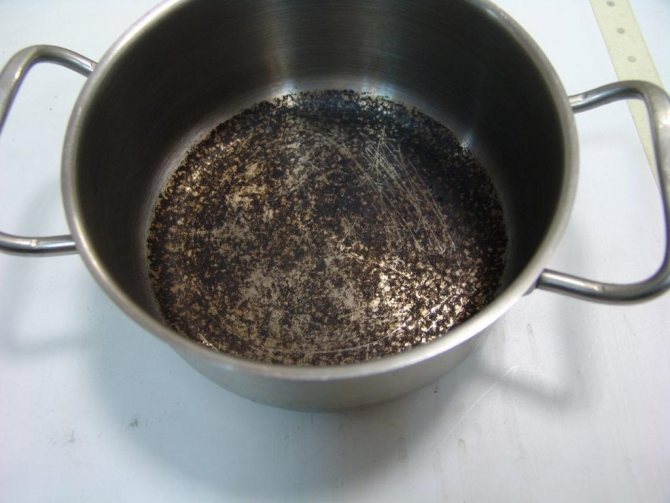 Many people wonder why food burns on the stove.
Many people wonder why food burns on the stove.
Five reasons:
- Poor quality cookware. Even branded non-stick products are short-lived - they last for a maximum of 3 years, and the age of fakes is even shorter. In our age of cheap "disposable" things, unscrupulous manufacturers even allow themselves to enamel pans with violations of technology in order to reduce the cost of production.
- Natural wear of the coating. For decades, only cast iron can serve.
- Mechanical damage that occurred on the coating during use and from improper handling - aluminum is often scratched, ceramic and Teflon - microcracks, enamel is prone to chipping and corrosion.
- Inattention of the owners - often the dishes burn on too high a fire or when the owners are distracted by something from the cooking process.
- Careless washing - a layer of fat remaining on the coating after poor-quality washing is readily mixed with soot, forming the basis for soot. Such dishes burn more often and faster.
 There are many reasons for burning food. One of them is the inattention of the owners when cooking.
There are many reasons for burning food. One of them is the inattention of the owners when cooking.
What to do if an enamel pan burns. Can it be cleaned?
Enameled coating is considered safe. The working surface of the pan (the one inside) can be enameled in certain colors - white, black, cream, blue or gray-blue. But even with the most careful attitude to the product, it happens that the food is burnt. Cleaning should start with soaking. To do this, you just need to pour water into it, but not cold.
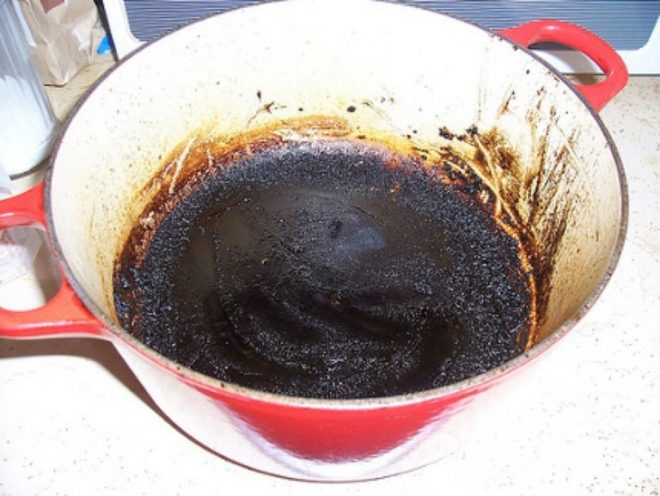
How to clean an enamel pan from burnt jam?
The main reason why burning can occur is the porous structure of the enamel.Very often, in the process of making jam, carbon deposits form at the bottom of the pan, which is not easy to get rid of. But still: how to clean the pan?
- Use table vinegar. 9% vinegar is an indispensable assistant for housewives. You just need to pour it on the bottom of the pan, and then after 1.5 hours, when the soot softens, it should be removed with a wooden spatula. The pot should be rinsed under running water.
- Try citric acid. Enamel is resistant to cleaning in an acidic environment, so the use of citric acid is an excellent solution for burning. First you need to dissolve a little dry citric acid, about 15-20 g per liter of water.Then cover all burnt places with this solution, boil everything for 20 minutes. Wait for a while until the pan cools down, rinse under running water.
- Laundry soap from burns. Enamel is not exposed to an alkaline environment, so soap is perfect for burnt jam. Pour a few liters of water into the pan to fill the burnt areas, then rub the soap into it and pour in the baking soda (150 grams). Boil the solution for 30 minutes. Then drain the water and clean the soot with a jet of water.
Boiling pans to clean burnt jam
Boiling is considered a common and very effective way to clean pots of burnt jam. Fill a pot made of metal material with hot water and pour 20 grams of soda into it. Then she should stand for about an hour without attention. Then put on fire and after the start of boiling, boil for another 15 minutes. Remove from stove, leaving to cool completely. Drain the water and soda, and wash the dishes in the usual way, using a sponge. All burnt food will fall behind, and the pan will shine from cleanliness.
The way to clean an enamel pan from burnt jam is somewhat different. Soda can not be used, but ordinary salt will cope with the dirt. Dissolve 6-7 tablespoons of this product in 1 liter of warm water. Pour the solution into a bowl and set to boil.After half an hour, it will be possible to clean the enameled pan without much effort.
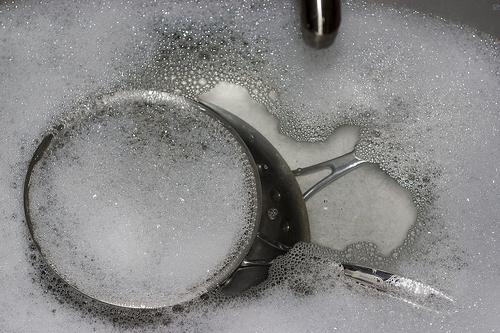
Special tools for dealing with severe burns
There are a variety of chemical agents for removing carbon deposits. Most of them are focused on cleaning something outside - stoves, ovens, and are not suitable for cleaning those surfaces that come into contact with food.Therefore, before use, you need to carefully read the instructions and make sure that the drug is allowed to be used for cleaning dishes. It should also indicate for which coatings it can and cannot be used.
To combat soot, the following industrial preparations are often used:
- "Shumanit". Reliable but aggressive. Not suitable for all types of surfaces, you need to carefully read the instructions. Has a pungent odor. Even heavy carbon deposits are removed in a short time. Liquid product, distributed in a spray bottle.
- "Mr Chister" An aggressive tool, less effective than Shumanit, but more economical. Available in liquid form, with a spray.
- Amway. Relatively safe, without a strong odor, not aggressive. At the same time, it is less effective, it may not be able to cope with a large soot. Available in the form of a gel.
- Comet. A popular cleaning agent for removing any dirt in the kitchen and in the bathroom. Available in gel and powder form. Less aggressive, but also less reliable than, for example, Shumanit.
- "Cillit". Effective, powerful tool in the form of a gel. Copes even with old pollution.
There are many funds, all are available in the form of a gel (liquid) or powder. The question is which is better. Abrasive cleaning compounds are applicable only to cast iron cookware and stainless steel pots. On other coatings, powders will leave scratches, so gels should be preferred. Before using this or that composition, you need to make sure that it will not harm the container.
All carbon removal chemicals should be used in a well-ventilated area, away from children or pets.Be sure to wear protective gloves, avoid getting the product on the skin, in the eyes. After cleaning, thoroughly wash and rinse the dishes with clean water, and ventilate the room.
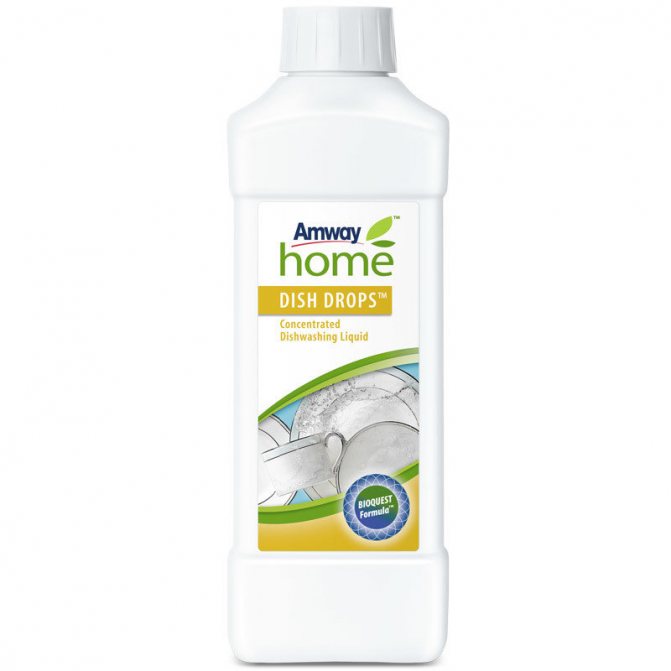 Amway
Amway
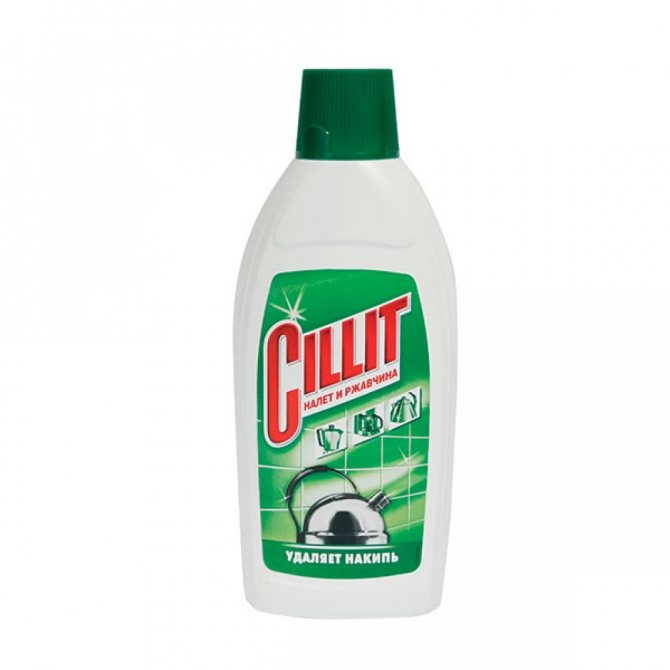 Cillit
Cillit
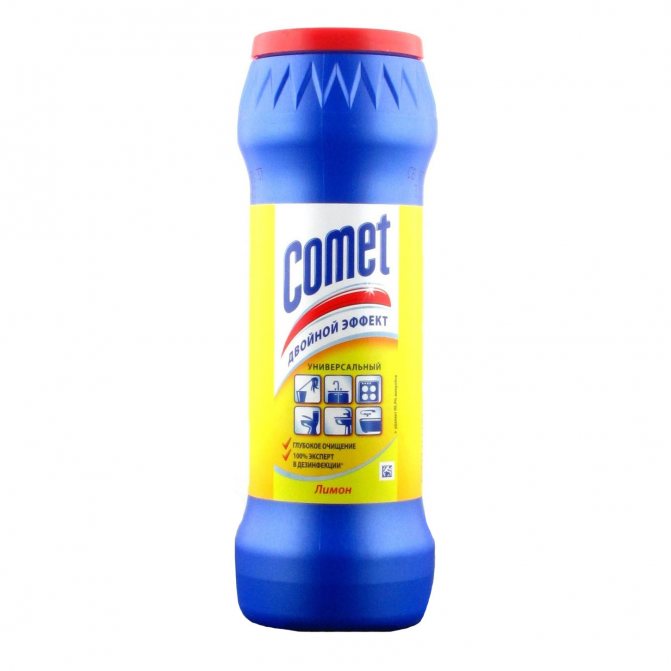 comet
comet
 Mr Chister
Mr Chister
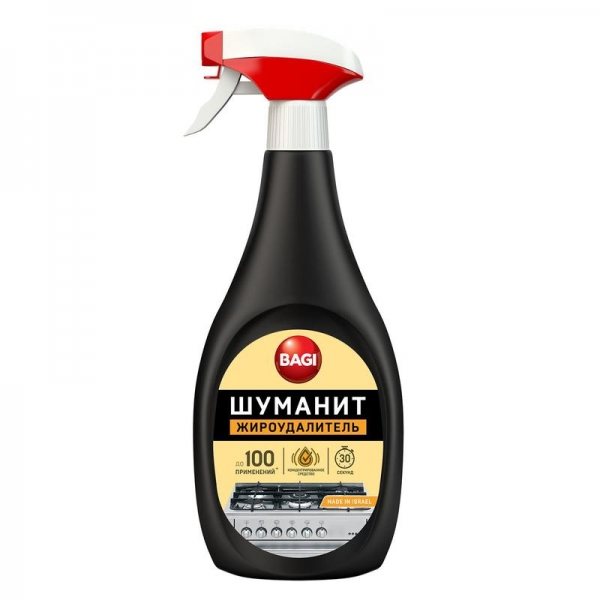
How to remove burn marks from the bottom of enamel cookware
Most often, soot sticks to the bottom of the container. It is extremely difficult to remove it from this surface. But this can be done using folk remedies. It is enough that the house has salt, sparkling water, or you can prepare a solution created from activated carbon.
Salt application
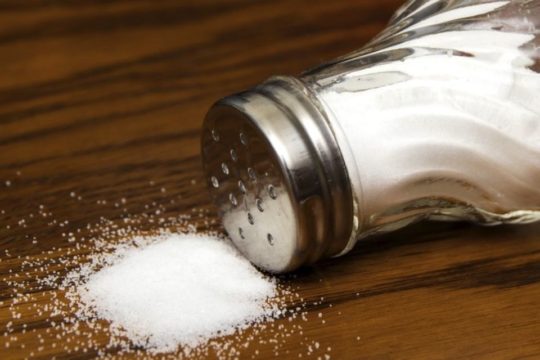
The advantage of salt is that it is not able to damage the enamel. Therefore, you can repeat the cleaning procedure repeatedly until a good result appears. First, prepare a saline solution by diluting 1 tablespoon of salt in 1 liter of water. Put the dishes on the fire and boil the solution for at least 30 minutes. Under the influence of salt, the scale will flake off and dissolve in water.
With sparkling water
Light and fresh soiling can be handled without boiling. Pour carbonated water from the dishes and leave to infuse for 30-60 minutes. The pollution will begin to oxidize and disappear. But carbonated water will not cope with intense blackening.
With activated charcoal
Activated charcoal is an effective and economical folk remedy used for cleaning enameled surfaces. We clean them with a solution prepared on its basis. Take 1 to 3 packs of tablets, depending on the degree of contamination. Unpack them and mash with a fork.Transfer the resulting powder to a saucepan and fill the container with water. Put the container on low heat and simmer for 20-25 minutes. Drain the solution formed as a result of boiling, cool the container, then wash it in the usual way.
What methods are considered less effective
Table salt also softens soot. You can cover the burnt bottom with salt, pour water and leave overnight.The hardened top will soften, but the layer adhering to the coating will still have to be further cleaned with soda or some kind of abrasive. Salt does not penetrate deep into the sugar crust, even after additional boiling.
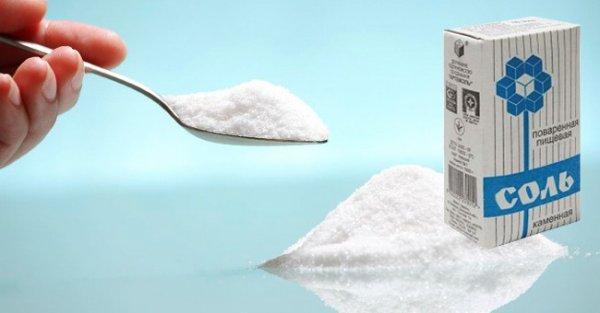
Dry mustard also has a weak effect. She copes with burnt fat, but she will not remove jam that is firmly stuck.
The most effective way to clean burnt jam from pots
A real hostess will not allow her pans to be stored in a cabinet dirty, with the remnants of burnt food. However, it happens that the adhering food is washed, but not scrupulously enough. Visually, the washing defect is not visible. But it is worth cooking ordinary jam in such a saucepan during the season, as sugar with berry mass begins to stick to the bottom and quickly burn even during continuous stirring. The reason is the poorly washed bottom of the dishes.
It is quite difficult to clean old areas of dirt. How to clean the pan from burnt jam in order to restore the shine and tidy look to the dishes? The most effective cleaning method is reserved for this case. It is worth trying it on enameled pans.
Before you clean the dishes from burnt jam, you should prepare all the necessary components of an effective detergent.To do this, for one serving, you need to take 50 grams of soda and the same amount of citric acid, combine with 100 ml of "Whiteness", and after mixing, add one and a half glasses of ordinary warm water. Pour the resulting solution into the dirty area and put on fire to boil. After 15 minutes, remove the dishes from the stove and leave to cool. After 20 minutes, without any sponges and rags, rinse the pan under running water. The keen eye will not see traces of burnt jam and old soot spots, and the enameled coating will again become snow-white.
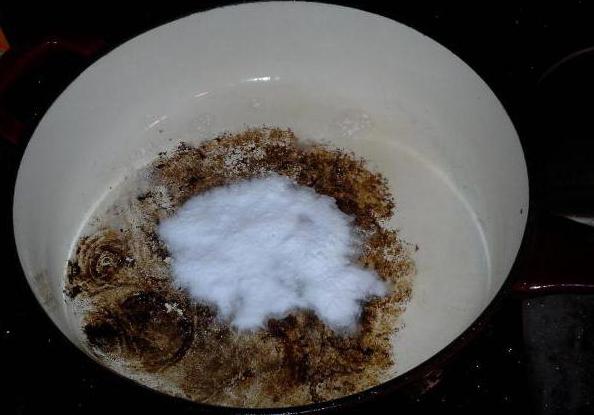
Severe cases of burning
Strong soot is when part of the food being prepared remains thick, up to a millimeter and more thick, with a black layer on the bottom and walls of the pan.Dealing with such a problem the first time is not always easy. But several attempts usually guarantee a good result. What are the ways to deal with the most severe burns?

To begin with, with a metal brush for washing dishes, carefully clean off the top soft layer of soot, being careful not to touch the enamel. The remaining hard and unwilling layer, pour a 9% vinegar solution so that the vinegar covers all the soot, and leave for 15 minutes. Acetic acid will soften the remnants of burnt food, which will allow you to get rid of it faster and easier in the future. At this preparatory stage is completed.
Main stage. Drain the vinegar solution from the dishes, pour cold water into it and add 1-2 tablespoons of citric acid. We put on fire, let the water boil and boil over low heat until the desired result is achieved. Gradually, the acid will act on the soot, and it will begin to peel off layer by layer from the surface of the dish.

As soon as you notice that a lot of soot has already moved away from the bottom of the dish, finish boiling. If the water has already boiled away, and soot does not give in, the procedure with citric acid must be repeated.
Further, everything is simple. Remove the pan from the heat, drain the water and again, very carefully, with a metal brush, clean off the loose layer, if any. At the end, we use ordinary dish detergents and a soft sponge.
Is Nagar still there? So you need to be patient, and repeat the boiling process with citric acid one or more times until the desired result is obtained.
To get rid of the unpleasant smell of burnt food, cover the pan with a damp, dense cloth (for example, a towel). After 10-15 minutes, the fabric will take all the smell out of the pan.
In this method, "chemical" home remedies are used more. You will need 1 tablespoon of soda and 1 tablespoon of regular table salt. We pour these funds over the burnt place, and pour the vinegar so that the liquid covers all the soot.
Attention! When you pour the vinegar, a chemical reaction (foaming) will begin. Don't let this scare you, everything is natural and safe. Close the pot with a lid and let it rest for about 3 hours. After this time, add some water and boil for 20 minutes.
In severe cases, these manipulations may not be enough. Therefore, leave the pan to stand and “think” for a day, and even better for 2-3 days. After the time is up, boil for 15 minutes. After the pan has cooled, clean off the remaining soot with a soft sponge and baking soda. Rinse thoroughly and ... the pan is like new!
Medium burns
It looks about the same as in the photo.
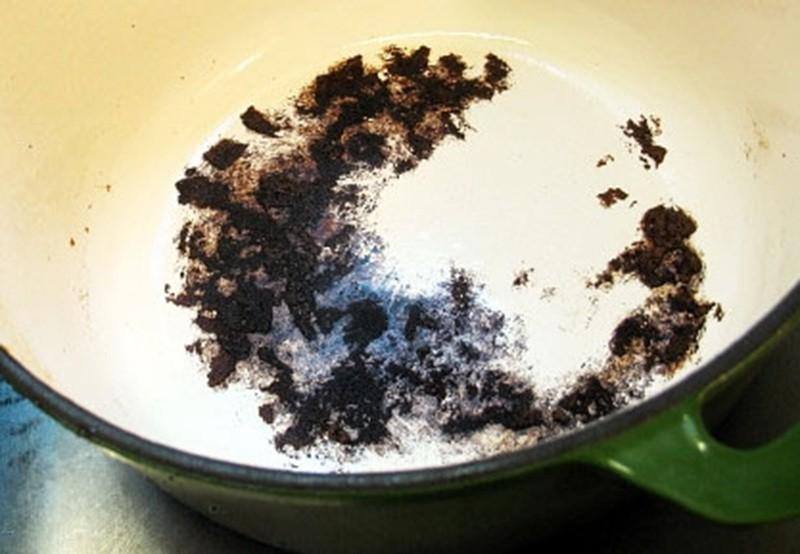
Surprisingly, the ability of activated charcoal to cleanse our body helps to cleanse our saucepans. To do this, crush the charcoal tablets (1 pack) and cover the affected areas of the dishes with them. Cover the pan with a lid and wait about 20 minutes. Then pour some warm water, covering all the soot with it. And again leave for 20 minutes, covered with a lid. Further actions: wash off the carbon deposits using a sponge and a cleaning agent.
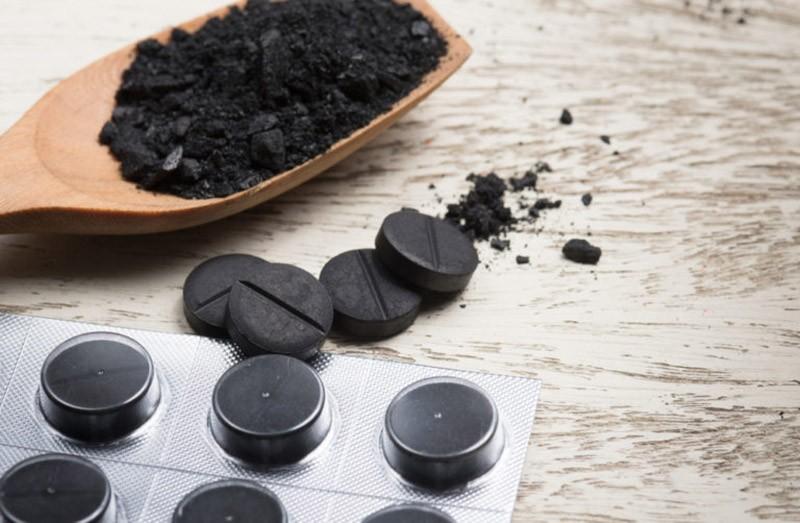
Just soda and nothing else. You will need an aqueous solution of soda with proportions, where 1 liter of liquid is mixed with 1 tbsp. baking soda crystals. The resulting solution should fill the pan 2-3 centimeters above the damaged surface. Put on the stove and boil for 30 minutes. For difficult cases - within 60 minutes. Drain the liquid and rinse the pan with any dishwashing detergent and a soft sponge. Nagar will lag well enough, but it will take a little effort and time to scrub off unwanted stains.
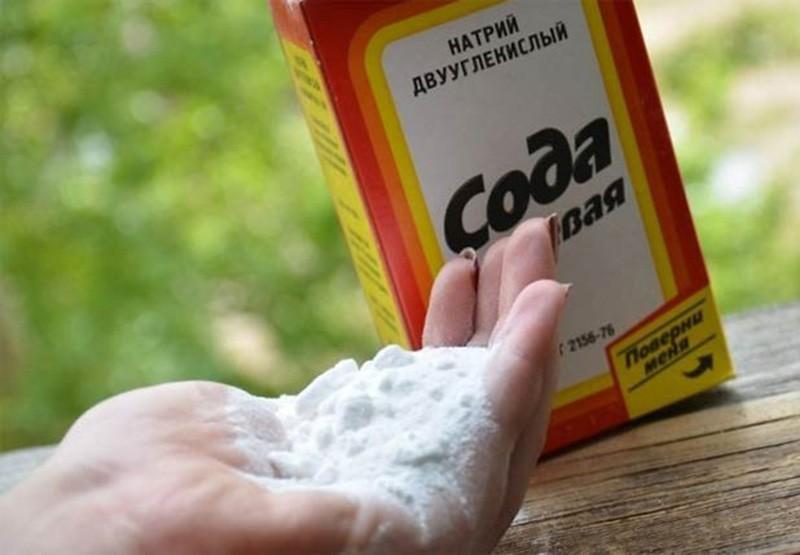
Some housewives advise taking 0.5 cups of soda for 1 liter of water, and after boiling, let the pan cool down with the solution without draining it.
Baking soda is especially good when a protein-based product (such as milk or meat) is burnt.
Actions similar to method No. 2 can no longer be done with soda, but with citric acid.1-2 tablespoons of acid for the amount of water that will cover the burnt bottom. Let it boil and boil for 10 minutes so that the soot begins to peel off. Then a few rubbing movements over the remnants of soot with a soft sponge with warm water. If brown stains remain, remove them with a mild abrasive powder dishwashing detergent.It may not turn out perfect, but it will become so after regular washing of the pan after a few times.
Light cases of burning
Pour in vinegar and leave for 2-3 hours. It is better not to use vinegar essence because of its pungent odor. If there is no vinegar in the house, you can use citric acid or lemon juice dissolved in water, after pouring boiling water over the lemon so that it gives the maximum of its acidic properties.

Apple peel also contains acid, so it may well be useful if it is boiled in a pan where food has burnt.
Acid helps well in cases of burning a product containing sugar.
Soda. A good and long-familiar cleaning agent for many housewives. In mild cases of burning, it is enough to wipe the darkened place with soda using a sponge. A few minutes and the result, as they say, is obvious.
Dark stain removal
Over time, enamelware tends to become covered with a dark coating. This is especially facilitated by cooking vegetables, for example, for vinaigrette. After a few months, you will notice that your pan has lost its original snow-white appearance. We share cleaning tips to remove dark plaque.
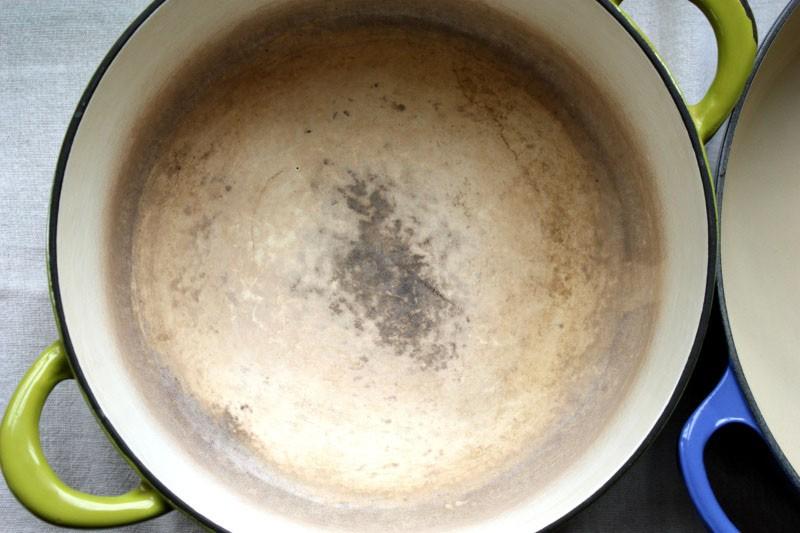
Dishes can be cleaned with baking soda. “Dry” or boil the pan with a solution of soda for 30 minutes, as recommended above. You can use two other, more effective methods using bleaching agents.
The “Whiteness” remedy, familiar to many, helps to remove plaque without much effort. Pour water into the pan so that it covers the entire surface where there is plaque. Add “Whiteness” to the water (2-3 tablespoons per 1 liter of water) and leave to stand for about a day.A significant part of the raid will definitely go away.A necessary condition - after the procedure with “Whiteness”, boil a pot of clean water twice to avoid chemical poisoning and remove odors.
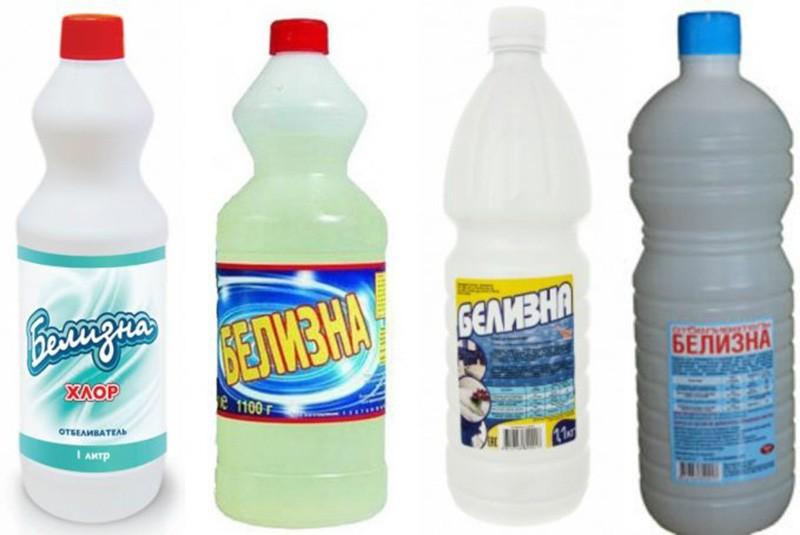
2 tablespoons of dry bleach will do the trick, but with the help of a boiling process. Add bleach to a pot filled with water, bring to a boil and let simmer for about 3 minutes. After that, it is enough to drain the water and make sure that all plaque has disappeared. Do not forget to thoroughly rinse the surface with plenty of water and be sure to boil 1-2 times with clean water for the final removal of the chemical agent.
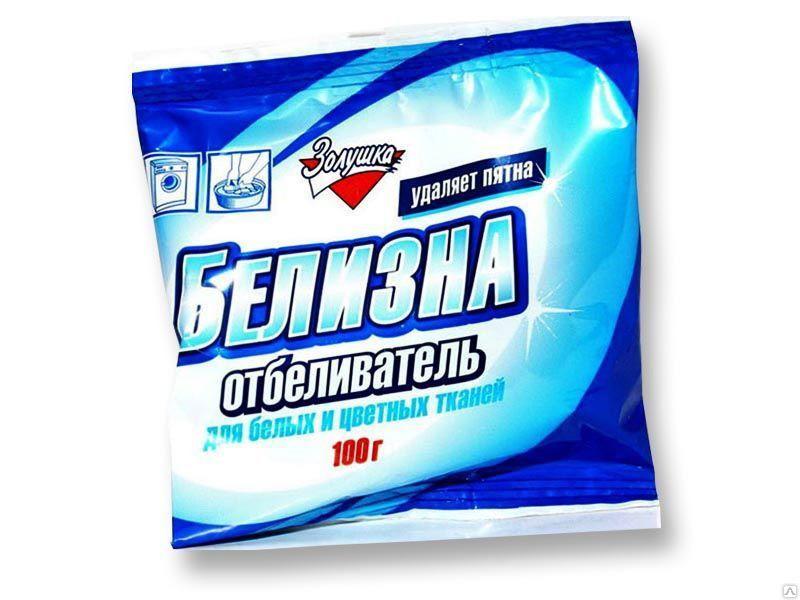
If you want to change enamelware to stainless steel cookware. Then we offer you an article on how to choose stainless steel dishes and not fall for the tricks of manufacturers.
Recommendations for the use of enamelware
And finally, a few tips for those who like to cook in enamelware.
- For a longer service life, the enamel of a newly purchased pan must be hardened. Fill a bowl with water and bring to a boil. Then remove from heat and let cool without pouring out the water.
- Enamel does not like sudden temperature changes, so do not put an empty pan on a hot stove. And do not pour cold water into a pan that has not yet cooled down.
- Unless necessary, do not use metal brushes, a knife or coarse abrasive powders to remove carbon deposits. This will damage the enamel. The resulting scratches will darken during subsequent cooking, which will spoil the appearance of the dishes. In addition, in place of the damaged enamel, the products will now burn constantly.
Care rules
There are a few simple rules that you should follow so that kitchen utensils last a long time:
- Do not use abrasive cleaners to clean enamel and ceramic dishes. They damage the coating of the dishes, and it becomes unusable.
- Enamel on the dishes does not like a sharp temperature drop. Therefore, do not put a hot pan, removed from the heat, under cold water.
- Cast iron rusts, so before you put the dishes in the cabinet, they must be thoroughly dried or wiped dry.
- It is not recommended to wash cast iron and stainless steel in the dishwasher.
- To wash ceramics, use the low temperature setting.
Precautionary measures
When using chemicals to clean dishes, you need to be quite careful. Many types of products are aggressive, so when working with them, you should use rubber gloves to protect your skin. It is also very important to avoid contact with the eyes. If this does happen, then the eyes should be rinsed with plenty of water.
It is important to remember one rule - after using any chemicals for washing and cleaning dishes, a good rinse with water is required. When using bulk detergents and cleaners, pour these powders with particular care to prevent small particles from entering the respiratory tract. After such cleanings, it will be best to ventilate the room. Of course, it is necessary to store detergent chemicals in places inaccessible to children or pets.
Soot prevention
How to avoid the appearance of soot on the dishes? Follow these simple guidelines for its use:
- Carefully monitor food preparation, do not leave cooking dishes unattended, and adjust the fire under the pot or pan in time.
- Control the presence in the dish of the right amount of liquid (sauce, water), oil, fat.
- Do not use metal accessories that can scratch the walls and bottom of dishes for mixing and laying food. There are plastic and wooden spoons and spatulas that are safe to cover.
- Try to avoid washing with metal brushes and sponges.
- Do not store (even short-term) wet cookware - moisture is an excellent breeding ground for mold, and mold will destroy the non-stick coating.
- Frying pans (especially) with Teflon and ceramic coatings should not be stored stacked one inside the other - the top one can damage the coating of the bottom one.
- To prevent aluminum pans or other porous metal pans from burning, it is recommended to use apple cider vinegar. It should be added when the bottom is already filled with oil and warmed up. On a slow fire, the vinegar will quickly evaporate, without affecting the taste of the future dish, but will help protect the metal surface from soot.
- Salt is used in a similar way - it is also poured into the bottom of the pan, already greased with oil or fat. It must be poured sparingly so that the dish does not subsequently turn out to be oversalted. If you happen to add an excess amount of salt, it is easy to remove the excess with a napkin or kitchen paper towel.

If you follow the simple rules for the operation of dishes, the appearance of soot can be avoided.
Even the best hostess is not immune from burning food in a pot or pan - but there are many ways to help get rid of an ugly burn. And in order to avoid this fuss, it is recommended to operate your "kitchen helpers" carefully and responsibly!
